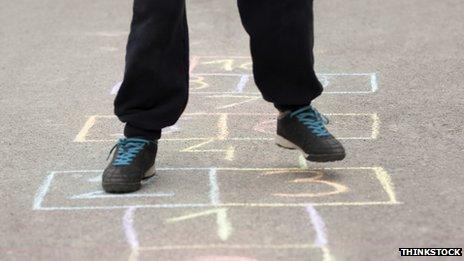Funding gap 'costs poorest-funded schools 40 teachers'
- Published
- comments

Schools funding is a game of unequal numbers
Schools in the worst-funded areas of England each receive the equivalent in funding of 40 teachers less than those in the best-funded ones, heads say.
Analysis by the Association of School and College Leaders suggests poorest-funded schools will receive £1.9m less than the best-funded in the next year.
General secretary Malcolm Trobe said an outdated grant system was to blame.
The Department for Education said it had increased budgets for the 69 least fairly-funded areas for 2015-16.
Mr Trobe said: "School funding is a postcode lottery. In many areas, schools receive inadequate funding because of a historic grant system that does not work.
"Instead of reforming the system, successive governments have tinkered with it and failed to fully resolve the problem.
"It means that many schools must struggle with resources which are simply not sufficient for the job they are expected to do."
'Levels of deprivation'
The ASCL analysis shows that schools in the 10 best-funded areas will on average receive grants of £6,297 per pupil in 2015-16, compared with an average of £4,208 per pupil in the 10 most poorly funded areas.
The association says that for a typical secondary school of 920 students, this equates to a budget of £5.8m in the best-funded areas and £3.9m in the most poorly funded - a difference of £1.9m.
This is enough to pay the total costs - salaries and pension contributions - of 40 full-time teachers, the ASCL said.
These figures are derived from the baseline amounts that local authorities get from government through the Direct Schools Grant.
They do not include pupil premium money - targeted at children from disadvantaged backgrounds - or money for individual children with special educational needs.
'Enshrined in the system'
But the association argues that this makes it a fair comparison because the schools will need that extra money for their disadvantaged and special needs pupils.
Mr Trobe said: "Funding levels rightly take into account levels of deprivation, and those in London also receive weighting for the higher costs they face. These factors account for some of the variation in funding levels.
"However, the underlying problem continues to be that funding is still impacted by historical factors going back to the 1980s when government grants were allocated to local authorities according to the amount they had traditionally spent on education.
"This means that funding inequities which existed then were enshrined in the system, and this has been a continuing problem ever since, resulting in inconsistencies across the country."
The five most poorly funded areas in England

Wokingham, Berkshire £4,158
Poole £4,194
South Gloucestershire £4,196
Stockport £4,206
West Sussex £4,206

Suzanne Richards, head teacher of The Holt School in Wokingham, Berkshire, the lowest funded local authority in England, said she had real concerns about funding.
She said that since 2011-12 her budget had fallen by £200,000 and a further cut of £150,000 is expected this year.
"Yet nationally we are told education funding is not being cut," she said.
"We are having to review all costs, contracts and staffing in all areas.
"There have sadly been some staff redundancies already and only essential staff are being replaced if anyone leaves voluntarily."
A Department for Education spokeswoman said: "As part of our plan for education, we have protected the schools budget, allowing us to ensure all local authorities are receiving the same initial basic amount per pupil as in 2010, and have committed to introducing a national funding formula after the next spending review.
"We have put an extra £390 million into the schools budget for 2015-16 to increase the per-pupil budgets of the 69 least fairly funded areas.
"This will, for the first time, mean a minimum level of funding for councils based on the characteristics of their pupils and schools, and is the biggest step towards fairer funding in a decade."
A national funding formula distributes money according to need, which means areas will always receive different levels of funding depending on characteristics such as deprivation, the DfE said.
- Published10 May 2011
- Published12 March 2015
